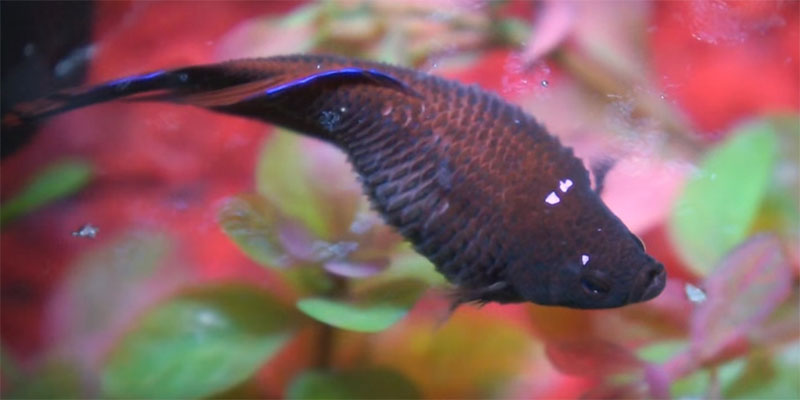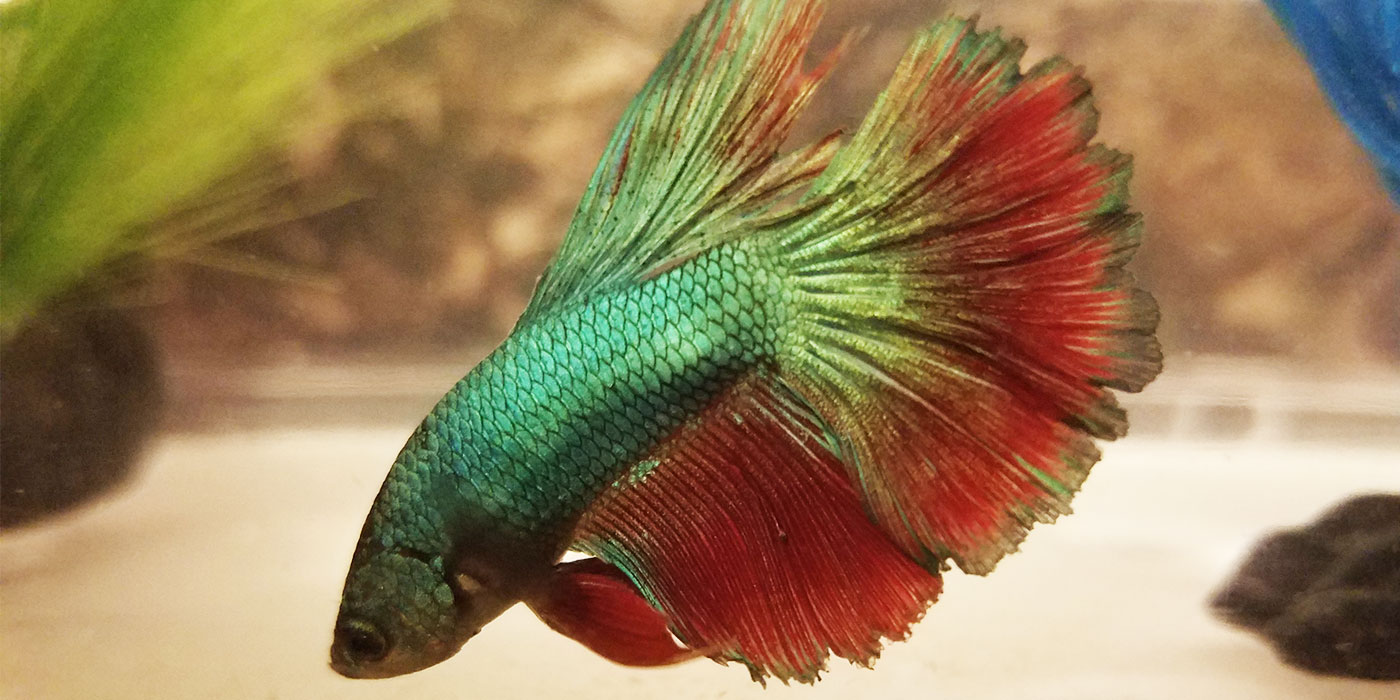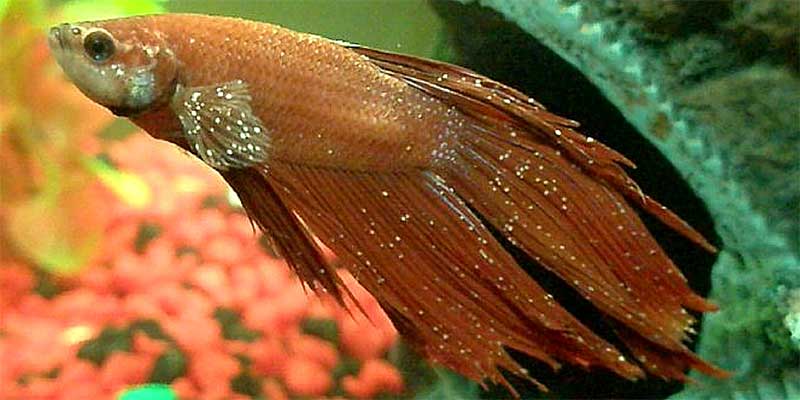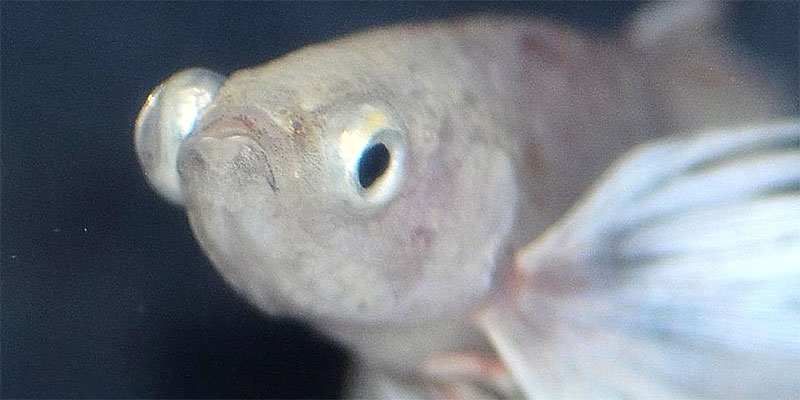How To Treat Betta Fish Popeye
Please notation: this page contains affiliate links
If you have a sick betta fish, you're probably feeling a little scared, dislocated, and anxious nigh how this happened. While relatively hardy fish, betta fish can suffer from parasitic, bacterial, and fungal diseases merely similar any other freshwater fish.
Quick identification and treatment will minimize potential harm and go your colorful friend swimming happily once more. The best way to keep your betta fish from getting sick is to go along them happy and healthy by following proper betta fish care.
It'southward ever better to exist proactive than reactive. Only similar you wouldn't want to be freezing or living in a dirty and cramped dwelling house, your betta fish doesn't either! That would eventually get you sick too.
Sick Betta Fish Behavior
- Lethargic: Inactive, lazy, lacks aggression, hiding
- Refusal to eat for extended periods of fourth dimension (due east.g. days)
- Faded colors, mainly in male person bettas
- Labored breathing
- Damaged fins
- Clamped fins
Certain behaviors are linked to a stressed or sick betta fish and non necessarily a full-diddled disease withal. Identifying these behaviors (listed to a higher place) is the easiest mode to tell if your betta fish is sick. Noticing these behaviors and correcting the problems early is very important. Failure to do so could exacerbate the problem and lead to more severe complications.
Betta Fish Diseases
The most prevalent betta diseases are listed below…
| Disease | Symptom(s) | Cause(south) | Handling(southward) |
|---|---|---|---|
| Columnaris | Cottony white growths forth the body and/or gills. | Stress, poor h2o quality. | Clean water and/or Anti-fungal medication. |
| Dropsy | Extreme body swelling and pineconing of scales. | Virus, bacterial infection, or parasites. | Kanamycin Sulfate or Maracyn II |
| Hole in Head | Visible holes to a higher place the eyes. | Poor nutrition and water quality. | Make clean water and proper betta fish food. |
| Ich/Ick | Small white dots on body and fins, rubbing on decor. | Poor water quality, stress, or contagious companions. | Clean h2o and Rid Ich Plus or Mardel Copper Prophylactic |
| Fin & Tail Rot | Blackness/Cerise tattered and receding fin edges. | Poor h2o quality. | Clean water and aquarium salt administration. Severe cases require Maracyn Ii antibiotics, or Kanaplex |
| Popeye | Bulging center. | Prolonged exposure to bad water quality, or Tuberculosis. | Clean water and Maracyn II antibiotic or Kanaplex |
| Swim Bladder Affliction & Disorder | Floating on side, difficulty swimming or regulating depth. | Genetics, overfeeding, or bacterial infection. | Fasting 2-iii days. Maracyn 2 antibody. |
| Tumor | Lump or crash-land. | Varies | Outlook is usually fatal. |
| Velvet | Goldish-yellowish rust-like dusting. Rubbing on decor. | Stress, cold and poor water quality. | Clean h2o, 76-81 degrees Fahrenheit. Mardel Copper Condom. |
After diagnosis, y'all'll need to follow the treatment options right away and always strictly adhere to medication directions. Never stop treatment early equally this could increase a parasites immunity.
If your betta fish lives in solitude you may opt to treat them in their existing tank. If they live in a community tank, have carbon filters, or sensitive plants, you should quarantine them for disease handling in a separate hospital tank.
Betta Disease Pictures and Synopsis
Some betta diseases can be treated hands, while others may have gloomier prognoses. Bank check your betta daily for anything aberrant. During feedings and tank cleanings is a swell time to look for common symptoms of an ill betta.
Acquire your fish's personality besides! Doing and so allows you lot to quickly identify when they're interim strangely.
Columnaris (Cotton Wool or Mouth Fungus)
Both beneficial and harmful (Columnaris) leaner is nowadays in your betta's water. Under stressful habitat weather (e.g. overcrowded) and unmaintained water, bacteria may enter through lacerations, the mouth or gills. Visible, sometimes stringy cottony patches on the mouth, gills, or fins forth the torso will be present in Columnaris. Accelerated symptoms may also include visible lesions and gill damage.
Dropsy (Pineconing)

Dropsy tin be caused by numerous issues including viral disease, parasites, poor diet, and bacteria. Information technology's also mutual amongst keepers who feed their betta's live food.
Dropsy is really non a affliction, merely rather the symptom of what's going on inside the betta fish's trunk from other ailments. These ailments include fluid build up and the swelling of failing organs (liver and kidney). Dropsy is severe and visible from higher up. You'll discover extreme swelling in the abdominal area and outward flaring scales that resemble a pino cone. This is shown in the photo in a higher place and in the full video here.
The bacteria that triggered internal issues is contagious and can harm other customs tank members. Another symptom of dropsy is the tendency for betta fish to stay shut to the surface to easily go oxygen. Their appetite will also be nearly non-existent.
Fin Rot and Tail Rot

Fin rot or tail rot (melt) is probably the well-nigh common betta fish disease. It'southward often confused with tail biting, resulting from boredom, and tears on sharp tank decor.
Upon inspection, the tail (caudal) or other fins will show visible signs of the illness. These signs include ruddy or blackness tattered, sometimes bloody, edges along the affected areas and can atomic number 82 to trunk rot if not treated.
Typical behavior and personality does non usually change unless the betta is suffering from other ailments also. And to respond your next question, yes their fins can grow back!
Hole in the Caput
Normally caused by improper nutrition or habitat cleanliness, early signs of hole in the head illness include small sores, dents, or pin-holes on the surface of the betta's head and to a higher place its eyes. Over time these holes become increasingly larger lesions.
These cavities are easily visible and tend to travel along the lateral line of the betta. If diagnosed early, information technology tin can be cured like most betta fish diseases, merely in later stages, it becomes increasingly mortiferous.
Ich or Ick

Another one of the almost common betta fish diseases is Ich, and information technology's caused by parasites. Ich is characterized by small white dots that are like in size to a granule of saccharide. These spots are visible to the naked eye and announced along the body and fins of a betta fish.
Information technology'southward a very preventable and treatable affliction that is, nevertheless, uncomfortable for your betta. You may observe them rubbing against objects in the tank in an attempt to become the parasites off their body.
Popeye

This affliction affects a betta fish's center and will cause one or both to burl outwards. It can be very startling seeing these symptoms, but information technology is treatable. The most common cause of popeye is prolonged exposure to poor water quality.
If you monitor the quality of your betta's h2o and don't feed him or her live food, you should never experience information technology. Popeye on its own tin be cured without long-term damage or loss of sight, but sometimes information technology'due south a sign of tuberculosis. Tuberculosis is a more than serious and always fatal betta affliction.
Septicemia (Blood-red Streaks)
This rare disease affects betta fish who are stressed (due east.g. continual and quick changes in water temperature) or have been wounded. Septicemia is a bacterial infection that can be caused past calculation new customs fish without quarantining them, or feeding infected food.
It'southward not contagious and can be diagnosed by visible red streaks or bloody marks forth the body. High levels of nitrites, causing nitrite poisoning, can besides pb to red stripes. Rule this out kickoff by conducting a water test.
Septicemia may also develop alongside popeye. If left untreated, this illness could lead to organ failure and dropsy. Likewise note that septicemia is virtually impossible to detect on red-colored betta fish.
Swim Bladder Disease (SBD)
The swim bladder is located between the breadbasket and the fish's tail. Overfeeding can lead to bloating, constipation, and swim bladder disorder from the digestive tract pressing towards the swim bladder.
This is very mutual amidst betta'southward in captivity because of misinformation or lack of knowledge effectually how much to feed a betta fish. The instructions on the back of nutrient containers tin be misleading and commonly represent an over-interpretation.
SBD is non contagious and normally clears upwardly on its ain – unless information technology'south a birth defect. This disorder is more prevalent in young fry and select breeds like the double tail betta. Symptoms include difficulty pond, constantly being in an "S" shape, changing depths, the inability to get out the surface of the water, laying on the bottom, and the inability to swim horizontally.
Velvet
Velvet is a parasitic betta fish illness that causes a goldish-yellow or rust-like sprinkling of color on the betta'due south trunk, gills, fins – or all iii. Information technology's hard to diagnose and is all-time identified using a lite source, like a flashlight, and shining it on the betta.
Some betta fish exhibit marbling and unique coloring, and then make sure you rule that out beginning. Betta fish are known to change colors over time besides. Bettas with velvet will dart around the tank looking for spots to rub themselves on (simply similar Ich) in an try to get the parasites off. If left untreated, Velvet can lead to decease.
Velvet is highly contagious to other community fish too, especially in sororities. Treat community tanks even if the other fish announced to be healthy and without signs of the disease (better safe than pitiful). Velvet is caused by ongoing stressors, poor water conditions, and prolonged exposure to colder than tropical h2o temperatures.
Other Betta Ailments
Information technology's unsafe to administer medication to an otherwise healthy betta fish. If your betta fish is exhibiting any of the symptoms below, it'south not necessarily because they are sick or have a illness.
| Symptom(s) | Crusade(s) | Treatment(southward) |
|---|---|---|
| Constipation | Overfeeding, lack of fiber in diet. | Fasting 2-3 days, feeding a pea, high-quality betta food. |
| Lethargic | Cold h2o, high pH, nitrate, nitrite levels, stress, sickness. | Tropical water temperature of 76-81 Fahrenheit, h2o changes, hiding spaces. |
| No Ambition | Not hungry, cold h2o, old age, stress or sickness. | Proper feeding quantity and schedule. Identify potential sickness or illness. |
| Tail Biting | Boredom | Encourage flaring, add more plants or decor, and consider betta fish toys. |
Forestall Betta Diseases Earlier They Offset
This page outlines the almost common betta fish diseases and sicknesses you may run into as a hobbyist. Information technology is not an exhaustive listing of all potential diseases. The best way to deal with diseases and illnesses is to non go them in the first place. Be proactive instead of reactive.
Quick identification and treatment will ensure you're providing the best care and chances for overcoming the problem. Good for you bettas are active, aggressive, and have big appetites. Sick betta fish are the verbal reverse.
It's your responsibleness to larn how to intendance for and provide a suitable habitat for your betta fish. With that said, diseases amongst betta fish can and do happen somewhat frequently. As betta's go older their immune systems weaken, making them even more than susceptible to sickness and disease.
If you still have a question, please mail service information technology in the comments section below.
Source: https://bettafish.org/diseases/

0 Response to "How To Treat Betta Fish Popeye"
Post a Comment